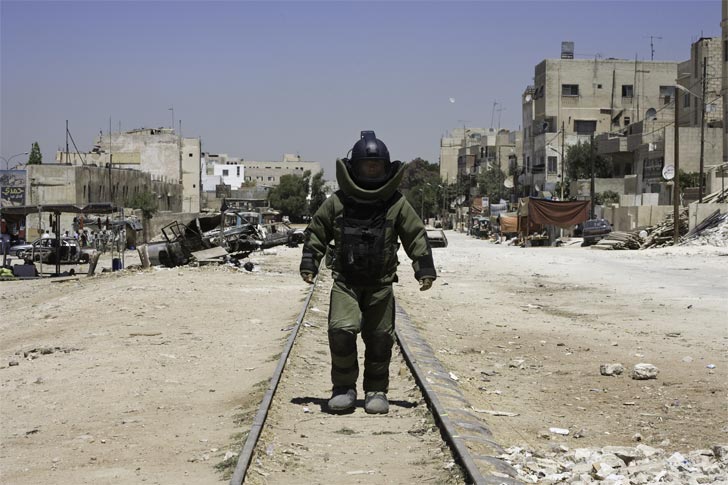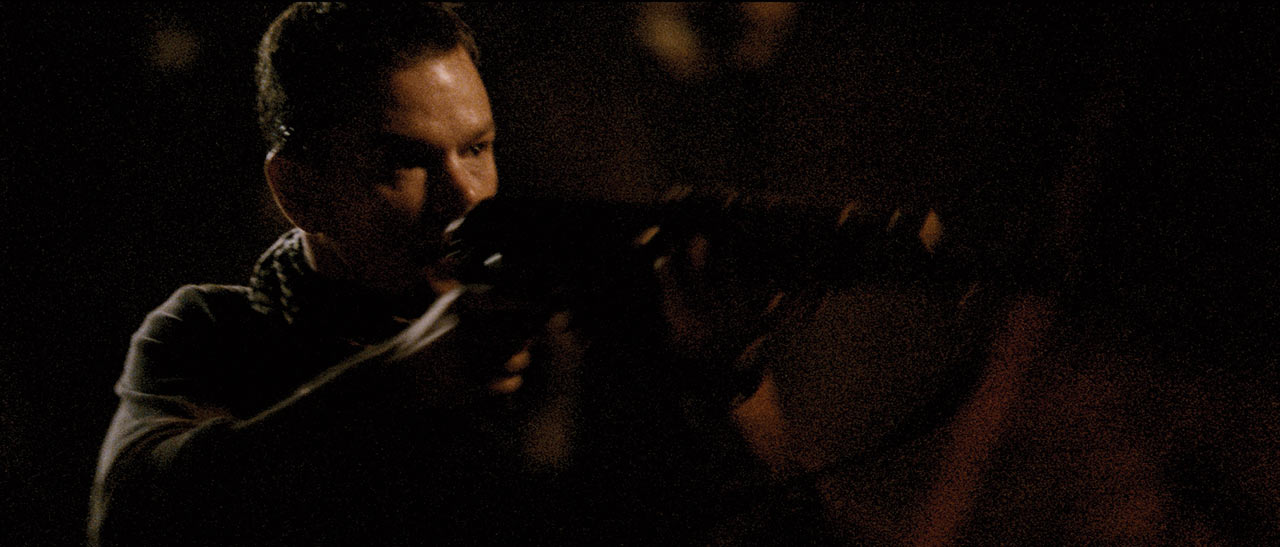 The Hurt Locker" title="Guy Pearce in The Hurt Locker">
The Hurt Locker" title="Guy Pearce in The Hurt Locker">
The Hurt Locker
The Hurt Locker opens in medias res, depicting a trio of soldiers working on the streets of Iraq. The movie doesn't stop to explain what they're up to or put their actions in context. The audience is left to infer the circumstance, but it's not hard to imagine the scenario. Judging from the cutting and the jumpy handheld camera style, we're looking at a tense situation. That robot rolling around by remote control, poking at a pile of refuse, is probably looking for a bomb. And when the robot breaks down and one of the men starts suiting up like Sigourney Weaver in the last scene of Alien, it's a sure bet he's about to play a game of red-wire/black-wire with a scary chunk of explosives. The tension is heightened, actually, by the fact that the movie has just begun. These characters are interchangeable and, because the movie has yet to present us with a formal protagonist, potentially expendable. That's how director Kathryn Bigelow gets way ahead of her audience in this film's very first sequence. Barely five minutes into her movie and already I was cowering in my theater seat, terrified that something was about to blow.
Watching The Hurt Locker, which follows a U.S. army bomb squad in a series of scrapes, shootouts and extremely delicate situations, is simultaneously a very diffuse and a highly focused experience. It's diffuse because most of the film lacks a narrative thread — it's really just a series of set pieces pitched at varying degrees of high intensity, with some thin connective tissue in between — and when something resembling a story arc eventually kicks in, it feels like the film is sacrificing verisimillitude in a bid for coherence. It's focused because, even though it lurches a little gracelessly from episode to episode, the imagery and mood within each segment is quite vivid. I don't remember any Iraq war film communicating so well the sense of aloneness that these men feel — the queasy sensation a soldier gets as he realizes that he, by virtue of his uniform and nation of origin, is the center of attention, and that some of the silent men scrutinizing him from apartment windows, rooftops, and the spires of minarets wish him harm.
In many of these moments, the soldier is not an stoic representative of the fighting force of the ass-kickingest world superpower, but rather a frightened and vulnerable outsider with a huge target drawn upon his person. That frisson of tension, of watching and being watched, that use of the rifle scope as a handy, ever-present extension of the eye, that awareness of the velocity of bullets and the potential frag spray of an IED detonation, those are the marks that The Hurt Locker hits repeatedly, the conventions of a new kind of war movie gaining hypnotic power as they appear over and over again. That's also why it almost makes sense to let the movie run more than two hours in length, even though it starts to feel a bit shaggy and distended by the time it's over. When you start to prune out the bits that don't work, you risk losing the potency of that repetition.
Most of the film's problems couldn't be fixed in a tighter edit, anyway. I kept feeling that the script, for its many virtues, was overwritten. The dialogue is too on-the-nose (especially if you compare it to the utterly disarming, verité feel of soldiers' shoptalk in HBO's Generation Kill last year) and the high-risk bravado of Staff Sergeant William James (Jeremy Renner), who eventually emerges as the film's central figure, is too much of a macho movie standby, although Renner does a mightily impressive job of dragging the character partway back from Toontown. The film is sidetracked for some minutes as James delves into the background of a young boy he's befriended who hawks bootleg DVD-Rs at the army base, and while the payoff has something to say about the seething mistrust between the Iraqis and their American occupiers, the execution feels a little perfunctory. And when the film resorts to cliché — as when James steps into the shower, fully clad in his combat gear and helmet, to wash away all his tears — it loses its grip.
But when Bigelow and writer Mark Boal (a journalist who was embedded with actual Baghdad bomb squads in 2004) get out of their own way, the results are extraordinary. Bigelow has always been a very fine director of action, but not since the first half-hour of There Will Be Blood have I seen a feat of sustained directorial prowess that exceeds what she exhibits in staging the very long standoff that occurs after James and company meet up out in the desert with a group of British mercenaries with high-value hostages in tow. And even as she successfully avoids the kind of crude ideological axe-grinding that has torpedoed many Iraq-themed movies, there's a chilly scene near the end of the film set in an American grocery store that's almost breathtaking in its psychological clarity. In the end, The Hurt Locker boils down to an affectionate but ambiguous tribute to the career soldier that's free of condescension, cynicism, or jingoism. (Music by Ministry is featured on the soundtrack, but it's not quite clear whether we're supposed to make the leap and perceive James as sharing Al Jourgenson's dim view of the Bush Administration.) It may well be designed to get musclebound young men to leave the theater declaring, "That movie was sick, bro," as indeed one such fellow opined to his buddy after I saw the film last night. No matter. Whatever its flaws, it's easily the best American fiction film about the Iraq war to date.
Posted by on June 30, 2024 9:12 PM

